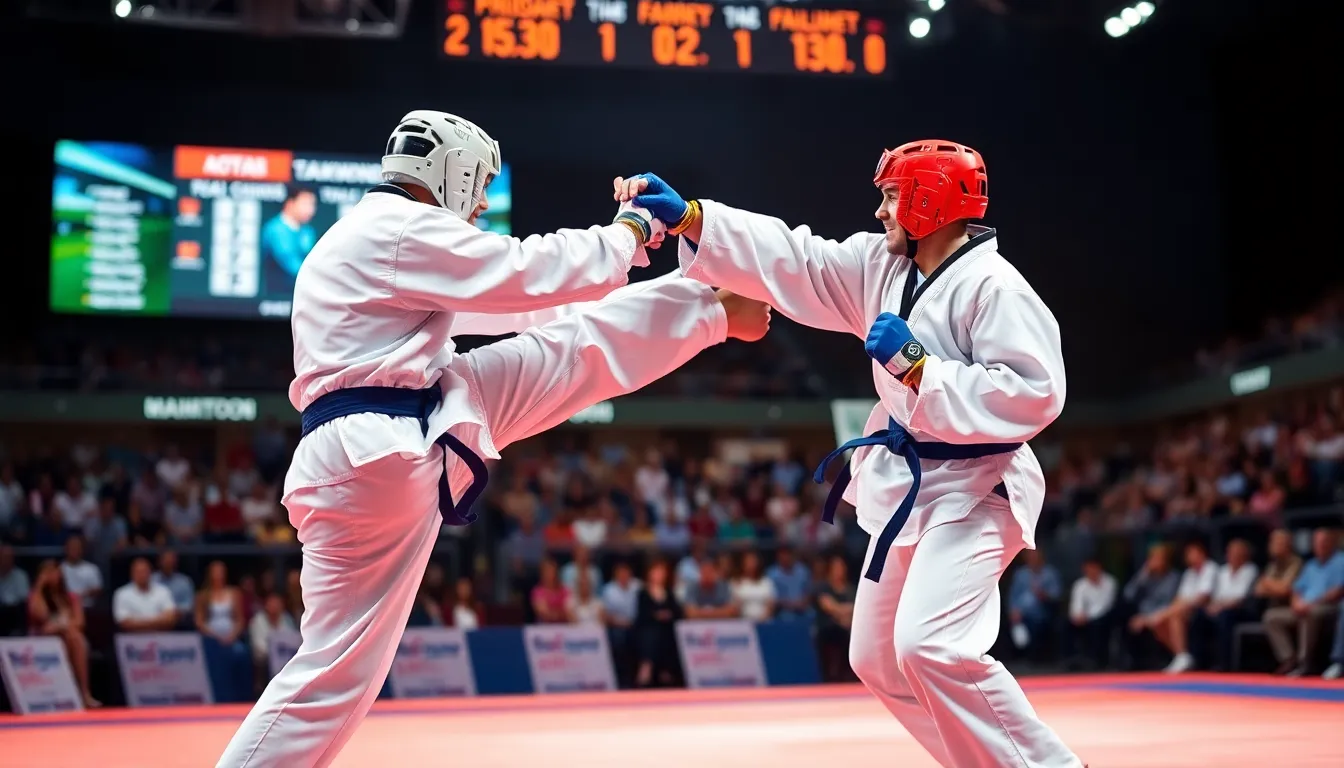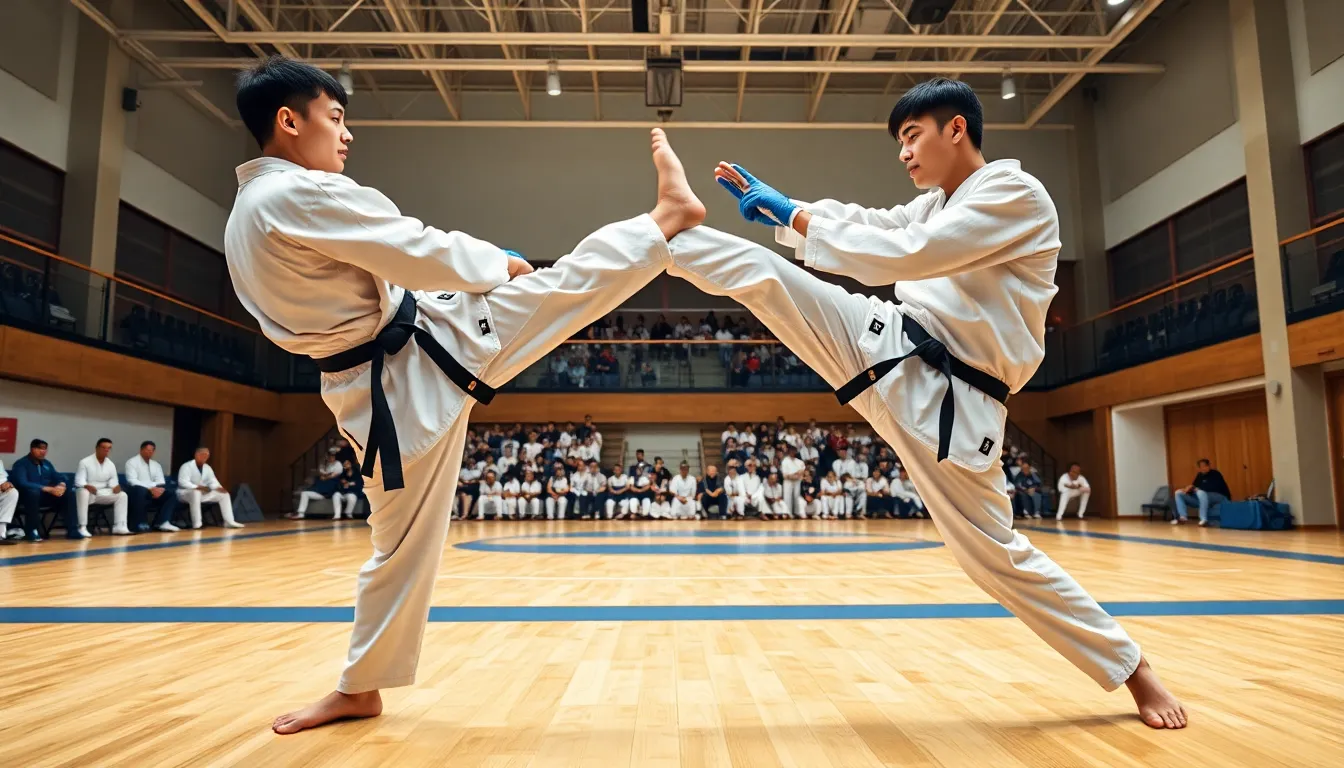Table of Contents
ToggleTaekwondo, an ancient martial art that’s captivated audiences around the world, isn’t just about cool kicks and flashy moves. It’s a complex sport filled with strategy, discipline, and yes, a fair bit of adrenaline. If you’re ready to jump into the intriguing realm of taekwondo bouts, buckle up, this journey is bound to be a wild ride. Whether you’re a seasoned black belt or a curious newbie, understanding taekwondo’s intricacies can up your appreciation (and maybe even spur you to take that first class).
Understanding Taekwondo Bouts

Rules and Regulations
Taekwondo bouts are governed by a detailed set of rules aimed at ensuring fair play and the safety of competitors. Participants must wear <a href="https://buzzillustrated.com/podcasting-camera”>protective gear, including helmets, body protectors, and shin guards. Matches are typically conducted within a square-shaped ring. What’s more is that bouts are divided into rounds, with each lasting two or three minutes depending on the level of competition.
The rules emphasize control and technique over sheer force: striking below the waist, for instance, is a no-go to prevent injuries. Referees are present not just to officiate but also to enforce scoring: they keep a sharp eye out for clean hits and penalize any unsportsmanlike behavior. In essence, the sport promotes respect, discipline, and skill.
Scoring System
Now let’s investigate into how scoring works, because what’s a bout without a way to keep score? Bouts are scored based on four criteria:
- Clean Kicks: A kick that lands on the opponent’s body or head.
- Controlled Techniques: Techniques delivered with the right power are vital for points.
- Use of Protective Gear: Points scored against an opponent are influenced by the effectiveness of strikes within the bounds of safety gear.
- Defensive Actions: Striking while demonstrating evasive maneuvers can earn points, too.
Points can vary: a clean kick to the head might earn a competitor three points while a kick to the body may net two. Points can add up fast in an electrifying match.
Types of Bouts
Olympic Taekwondo vs. Traditional Taekwondo
When someone mentions taekwondo, the term can broadly encompass various approaches. But primarily, the distinction lies between Olympic Taekwondo and traditional forms.
Olympic Taekwondo focuses heavily on sport, placing participants in a more directed environment where the goal is to outscore the opponent through technique and speed in a structured match. Competitors are awarded points based on clean strikes, which adds a dynamic edge to every contest.
In contrast, Traditional Taekwondo encompasses a rich cultural heritage with forms (poomsae) and self-defense techniques that go beyond the bouts. Participants practicing traditional styles often emphasize discipline, self-control, and the ethical side of martial arts, prioritizing character development alongside physical prowess. Each brings something unique to the table, captivating participants and audiences alike.
Key Techniques and Moves
Importance of Strategy in Bouts
In the realm of taekwondo, techniques speak louder than words. Competitors must master various strikes, including roundhouses, front kicks, and sidekicks, all of which play a crucial role in combat. But, it’s not just about throwing punches and kicks. In taekwondo bouts, strategy reigns supreme.
It’s essential to analyze the opponent’s weaknesses while simultaneously concealing your own. Timing and distance management become critical: knowing when to engage or retreat can turn the tide of the match. Many athletes rely on footwork, darting in and out of range, to confuse their opponents. This level of strategic thinking is what elevates a good competitor to a great one.
Psychological Factors in Taekwondo Competitions
Physical Preparation and Training
The mental gameplay of taekwondo can often be as challenging as the physical demands. Competitors must maintain focus even in the heat of battle, managing stress and anxiety while honing concentration.
Physical preparation is equally essential. Training sculpts strength and endurance, enabling athletes to execute intense movements without losing momentum. Practicing drills repeatedly ensures muscle memory kicks in when it matters most. Alongside rigorous training regimens, mental exercises such as visualization and meditation can arm competitors with a winning edge. They help build resilience, setting champions apart from the crowd.
Nutrition for Taekwondo Athletes
Injury Prevention and Recovery
Eating right sustains energy levels and repairs muscles, which is crucial in a sport as demanding as taekwondo. Athletes are encouraged to follow a balanced diet rich in proteins, carbohydrates, and healthy fats to fuel their training sessions and recovery.
Injury is an unfortunate reality in contact sports: prevention through proper warm-up and cooldown routines is key. Staying hydrated and maintaining overall health can minimize risk factors significantly. If an injury does occur, recovery involves rest and rehabilitation techniques such as physiotherapy. Strategies like icing, compression, and elevation help speed up the healing process, allowing competitors to return to the mat stronger.
The Future of Taekwondo Bouts
Emerging Trends in Taekwondo
As the world evolves, so does taekwondo. New trends are surfacing, including advancements in technology enhancing training and safety equipment. For instance, electronic scoring systems are gaining popularity, making the scoring process quicker and more accurate, ensuring fairness in competition.
Also, there’s been a growing emphasis on inclusivity, such as the introduction of para-taekwondo at the Olympics. Wider access encourages more individuals from diverse backgrounds to participate, enriching the taekwondo community and adding variety to competition styles. These advancements not only promise to shape the sport but also inspire the next generation of taekwondo practitioners.




